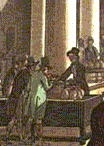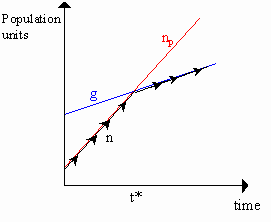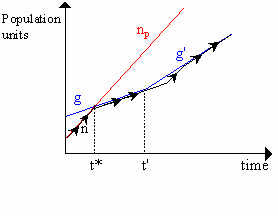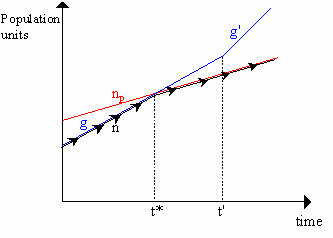|
________________________________________________________ "[I]t is evident that every man in the lower classes of society who became acquainted with these truths, would be disposed to bear the distresses in which he might be involved with more patience; would feel less discontent and irritation at the government and the higher classes of society, on account of his poverty; would be on all occasions less disposed to insubordination and turbulence...The mere knowledge of these truths, even if they did not operate sufficiently to produce any marked change in the prudential habits of the poor with regard to marriage, would still have a most beneficial effect on their conduct in a political light." (T. Robert Malthus, Essay on Population, 1803 [1872]: p.591-2) "Of all the men of talent whose writings I have read up to this hour, Mr. Malthus has the most perplexed understanding. He is not only confused himself, but is the cause that confusion is in other men." (Thomas De Quincey, "Measure of Value", London Magazine, 1823: p.136) "O wonderful Malthusian prophets! Millenniums are undoubtedly coming, must come one way or the other: but will it be, think you, by twenty millions of working people simultaneously striking work in that department; passing in universal trade unions, a resolution not to beget any more till the labour-market become satisfactory?" (Thomas Carlyle, 1839, Chartism) ________________________________________________________ Contents (A) The Malthus Hypothesis (A) The Malthus Hypothesis As is well known, Robert Malthus, in his 1798 Essay on Population, posited the hypothesis that "Population, when unchecked, increases in a geometrical ratio. Subsistence increases only in an arithmetical ratio" (Malthus, 1798: p.9). The precise ratios aside, the essence of the claim is that the natural ("unchecked") rate of growth of population exceeds the rate of growth of the food supply (i.e. means of subsistence). The critical word here is "unchecked". It seems sufficiently clear that Robert Malthus (1798, 1872; 1820, 1830) had not argued that the actual rate of growth of population exceeded the actual growth of the means of subsistence. What he had argued was that the theoretically-possible growth of population exceeded the actual growth of means of subsistence. From this he concluded that there was a tendency for actual population to expand when per capita income rose. In Malthus's story, then, there are three growth rates at play. Let g be the actual growth rate of the means of subsistence, n the actual rate of population growth and np denote the potential growth of population. The potential rate np is the "unchecked" population growth, which is wholly governed by the biological and cultural propensities for reproduction among the population. In a nutshell, then, the Malthus hypothesis is that np > g, i.e. the potential rate of population growth exceeds the rate of actual food supply growth. In Figure 1, we have plotted three curves against time. The blue curve (with slope g) plots the units of total food supply divided by individual subsistence requirements, thereby measuring the number of people that can be sustained by the existing food supply at a subsistence standard of living. The black curve with arrows (with slope n) measures actual population. The red curve (with slope np) measures potential population. [Note: we have drawn the potential population curve as a straight line rather than an exponential curve, which would be more in accordance with Malthus's geometric progression. However, as nothing crucial about Malthus's theory hinges on this progression (and since Malthus does not explain how he calculated it), we shall stick to our simple straight-line representation.] If the food supply is not constraining, then actual population will grow at its potential rate; otherwise, it will be forced to accompany food supply growth. We can see this in Figure 1. Up to the time period t*, the actual growth rate is governed by the potential rate, so n = np and the red and black lines coincide. After the food barrier is hit at t*, then the black and blue lines coincide, so actual population growth conforms to the actual food supply growth (and thus falls below the potential population growth). In other words, before t*, n = np, while after t*, n = g.
Malthus was not the first to come up with this hypothesis. The "battle" between subsistence and natural population growth had been discussed by Giovanni Botero (1588), Sir William Petty (1686), Johann Peter Süssmilch (1741), Benjamin Franklin (1751), Robert Wallace (1753), Richard Cantillon (1755), Marquis de Mirabeau (1756), Sir James Steuart (1767), Joseph Townsend (1786) and Giammaria Ortes (1790). Malthus generously acknowledged many of his predecessors. (B) Misery and Vice How does actual population growth, n, conform to g, the actual growth rate of subsistence? Malthus argued that the "the superior power of the population is repressed, and the actual population kept equal to the means of subsistence by misery and vice." (1798: p.52). In other words, whenever actual population exceeds the subsistence level, there are automatic mechanisms -- "positive checks" ("misery") and "preventive checks" ("vice") -- that bring the population back down. It is these checks that prevent the black line in Figure 1 from venturing above the blue line. By "positive checks" Malthus meant phenomena that increase the death rate -- starvation, disease and related disasters like pestilence and war. He believed these were endogenous, arising when population growth was excessive. Diseases thrive when cities are overcrowded; desperate competition for food leads not only to starvation but also to riots, rebellions and wars which kill off thousands more. So, by intermittently killing off large numbers of people, positive checks help bring food supply per person back up to a manageable level. By "preventive checks", Malthus referred to the conscious decisions of humans to reduce the birth rate. This is also endogenous. When population pressure is high and food supply relatively scarce, men are reluctant to start large families. They prefer to postpone marriage (or abstain from it altogether) and/or limit the number of children they produce. So, fertility declines when food supplies per person are too low.
Malthus loosely characterized all positive checks as "misery" and all preventive checks as "vice". That increases in the death rate are "misery" seems self evident, but why characterize decreases in the birth rate as "vice"? The reason for the latter is that Malthus (who was, it must be recalled, a clergyman) regarded the unmarried state, if not a moral evil in itself, certainly one that led people to engage in "immoral" behavior like promiscuousness, adultery, prostitution, dissipation, etc. (Malthus, 1872: p.159-60). In later editions of his Essay, Malthus changed his tone and recognized that the birth rate may be reduced by moral restraint, by which he meant the "restraint from marriage which is not followed by irregular gratifications." (1872: p.160) and thus "does not come under the head either of vice or misery" (1872: p.149). In other words, Malthus conceded that as long as bachelors and maidens behaved "properly" (i.e. remain celibate), then there is nothing morally wrong with staying unmarried. However, as a vicar of the Anglican Church, Malthus still refused to recognize artificial birth control methods as an acceptable way of restraining fertility. It is worthwhile recalling here that Malthus had written his 1798 Essay in response to the theories of William Godwin (1793) and the Marquis de Condercet (1795). Godwin and Condorcet had evinced an optimistic projection about the progress of civilization and the future "perfectibility" of mankind. But, for Malthus, the population problem meant that humanity would always be attended by "misery and vice", which are hardly consistent with human "perfectibility". In later editions of his Essay (it went through a further six editions, from 1803 to 1872), Malthus dropped his polemics against the optimists and concentrated on gathering empirical evidence for his population thesis. He was not quite "testing" his hypothesis scientifically. Rather, like an attorney, he gathered the evidence that supported his case and disregarded that which did not. (C) The Wage-Fertility Dynamics
Ricardo's (1817) theory of wages made use of the notion of "wage-fertility" dynamics, i.e. that rises in the real wage rate above some "natural" level will induce population growth. The gist of the argument, to use Richard Cantillon's (1755) folksy phrase, was that "men multiply like mice in a barn if they have unlimited means of subsistence". These wage-fertility dynamics can be deduced from Malthus's Hypothesis. Malthus's (1798) main interest was the relationship between n and np. The potential population growth rate (being the "natural" one) has a gravitational pull on the actual population growth rate. Thus, even if the actual growth rate is confined by the food supply growth rate, there still remains a tendency for population to grow faster -- just kept in check. This tendency is what yields the wage-fertility dynamics. We can see this in Figure 2. Suppose we have already passed time t* (i.e. food supply is constraining). Suppose that at time t˘, for some reason (e.g. improvements in agricultural technology), the rate of food supply growth increases from g to g' . But note that the Malthus Hypothesis still holds true as np > g˘. Now, if this is the case, then we should expect actual population growth n, after a brief lag, to also increase to g'. This is what we see in Figure 2 soon after time t˘. So, the Malthus Hypothesis implies that actual population growth will rise in response to an increase in the growth rate of income per capita. We have our wage-fertility dynamics.
In sum, Malthus had argued that society has already gone past t*; "the period when the number of men surpass their means of subsistence has long since arrived." (Malthus, 1798: p.57). As a result, the two main empirical implications of Malthus theory are (1) that n = g, "That the increase in population is necessarily limited by the means of subsistence." (Malthus, 1798: p.52) (2) that an increase in g will induce an increase in n, "That population does invariably increase when the means of subsistence increase." (ibid.) (D) The Anti-Malthus Hypothesis The Malthus Hypothesis was that np > g. The alternative "Anti-Malthus" hypothesis is that np < g. The consequences of the anti-Malthus hypothesis are depicted in Figure 3. Here, we see that the food supply is only constraining up to t*, while after t*, actual population growth is growing at its potential rate n = np < g.
Notice that this implies that an increase in the food supply growth rate (at time t' in Fig. 3) will not affect the rate of population growth. Income per capita can increase all it will without inducing greater population growth. Thus, the anti-Malthus hypothesis disables the mechanism of the wage-fertility dynamics.
|
All rights reserved, Gonçalo L. Fonseca




